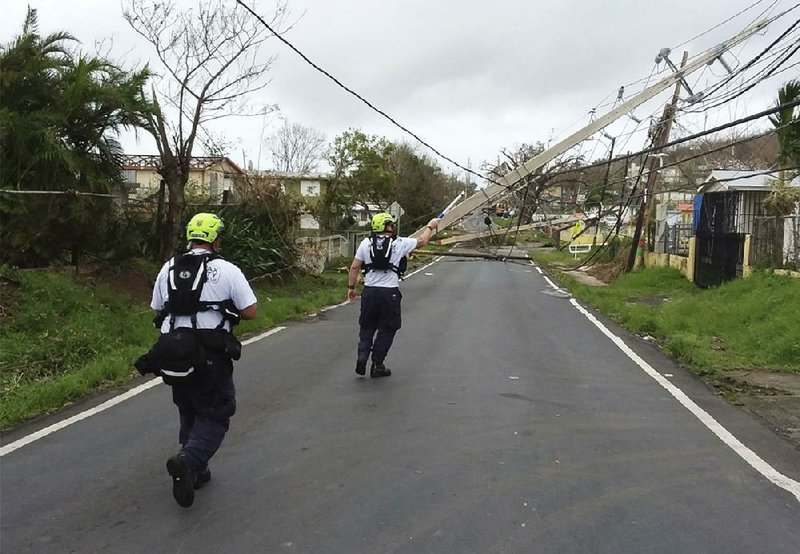SAN JUAN, Puerto Rico -- A humanitarian crisis grew Saturday in Puerto Rico for towns left without fresh water, fuel, electricity or phone service after Hurricane Maria struck the island Wednesday.
Anxious mayors arrived in the capital to meet with Gov. Ricardo Rossello to present a long list of items they urgently need. The north-coastal town of Manati has no fuel or fresh water, Mayor Jose Sanchez Gonzalez said.
"Hysteria is starting to spread. The hospital is about to collapse. It's at capacity," he said, crying. "We need someone to help us immediately."
By Saturday, the death toll from Maria in Puerto Rico was at least 10, including two police officers who drowned in floodwaters in the western town of Aguada. The number of deaths was expected to climb as officials from remote towns continued to check in with officials in San Juan.
Click here for larger versions
Photos by The Associated Press
Photos by The Associated Press
Authorities in the town of Vega Alta on the north coast said they had been unable to reach an entire neighborhood called Fatima, and were particularly worried about residents of a nursing home.
"I need to get there today," Mayor Oscar Santiago said. "Not tomorrow, today."
Rossello said Maria would clearly cost more than the previous major storm to wallop the island, Hurricane George in September 1998. "This is without a doubt the biggest catastrophe in modern history for Puerto Rico," he said.
A dam upstream of the towns of Quebradillas and Isabela in northwest Puerto Rico was cracked but had not burst by Saturday afternoon as water continued to pour out of rain-swollen Lake Guajataca. Federal officials said Friday that 70,000 people, the number who live in the surrounding area, would have to be evacuated. But Javier Jimenez, mayor of the nearby town of San Sebastian, said he believed the number was far smaller.
[HURRICANE TRACKER: Follow Maria’s projected path]
Secretary of Public Affairs Ramon Rosario said about 300 families were in harm's way.
The governor said there is "significant damage" to the dam, and authorities believe it could give way at any moment. "We don't know how long it's going to hold. The integrity of the structure has been compromised in a significant way," Rossello said.
The 345-yard dam, which was built around 1928, holds back a man-made lake covering about 2 square miles. More than 15 inches of rain from Maria fell on the surrounding mountains, swelling water in the reservoir.
The Federal Emergency Management Agency said Saturday that meals, water and supplies were being delivered to the island and that some airports were reopening. But it was not clear how quickly relief would reach the people, and fully restoring power and communications was expected to take quite some time.
"This is going to be a long and frustrating process for everybody. There is tremendous damage on the island," said William Booher, director of public affairs for FEMA.
Booher said there was no difference in the agency's response in Puerto Rico, compared with Texas, Louisiana and Florida after recent hurricanes. FEMA has had sufficient resources to deal with back-to-back-to-back hurricanes, he said, adding that "we've been able to address each one of them."
Suggesting a long slog ahead, the Energy Department said in a statement that roads in Puerto Rico must be cleared before emergency responders can assess damage, and "from there, the work of power restoration can begin."
The island's electrical grid was in bad shape long before Maria struck. The territory's $73 billion debt crisis has left agencies like the state power company broke. The company abandoned most basic maintenance to its system in recent years, leaving the island subject to regular blackouts.
The Energy Department said Saturday that it had some emergency personnel on the island during the storm who were being redeployed to the U.S. Virgin Islands, but added that emergency responders would be in Puerto Rico "as soon as conditions permit."
The U.S. Army Corps of Engineers had more than 120 responders on the islands. Their work included providing temporary power, temporary roofing, infrastructure assessments and debris removal. And the National Guard Bureau had more than 1,600 service members offering support on both islands.
Because of Maria, at least 31 lives in all have been lost around the Caribbean, including at least 15 on hard-hit Dominica. Haiti reported three deaths; Guadeloupe, two; and the Dominican Republic, one.
In San Juan, Neida Febus wandered around her neighborhood with bowls of cooked rice, ground meat and avocado, offering food to the hungry. The damage was so extensive, the 64-year-old retiree said, that she didn't think the electricity would be turned back on until Christmas.
"This storm crushed us from one end of the island to the other," she said.
Information for this article was contributed by Michael Biesecker, Catherine Lucey, Matthew Daly and Danica Coto of The Associated Press.
A Section on 09/24/2017
